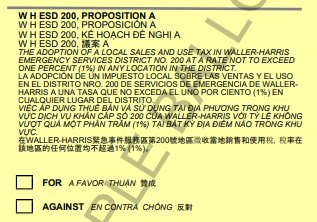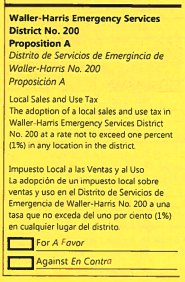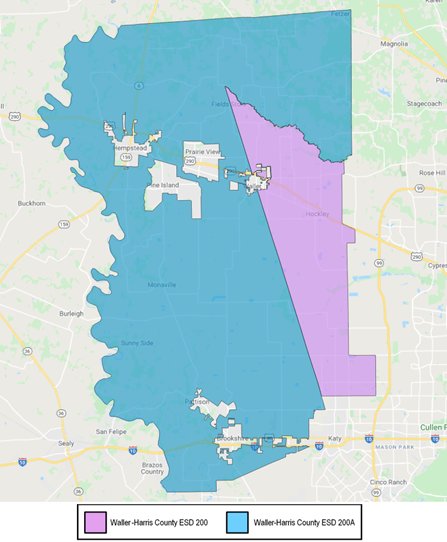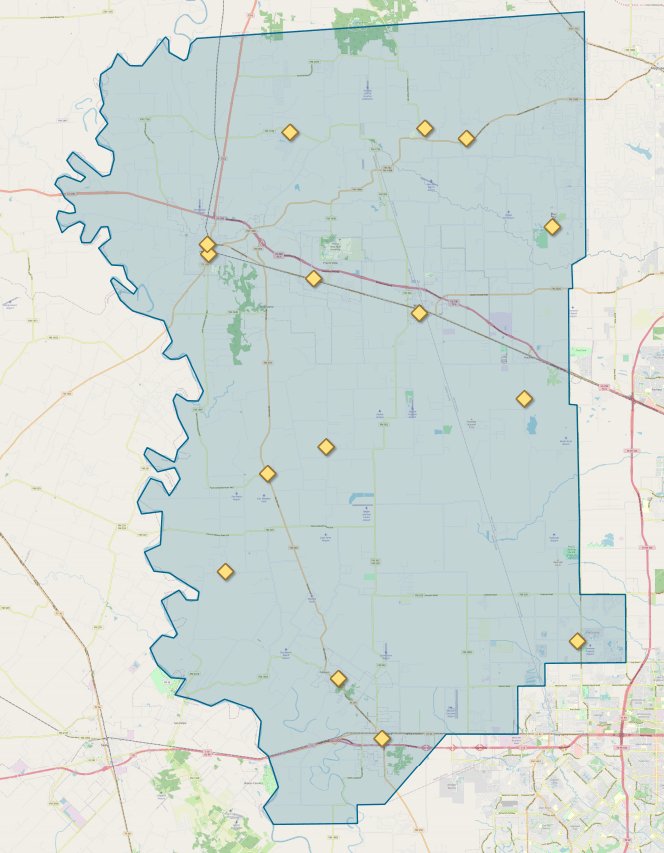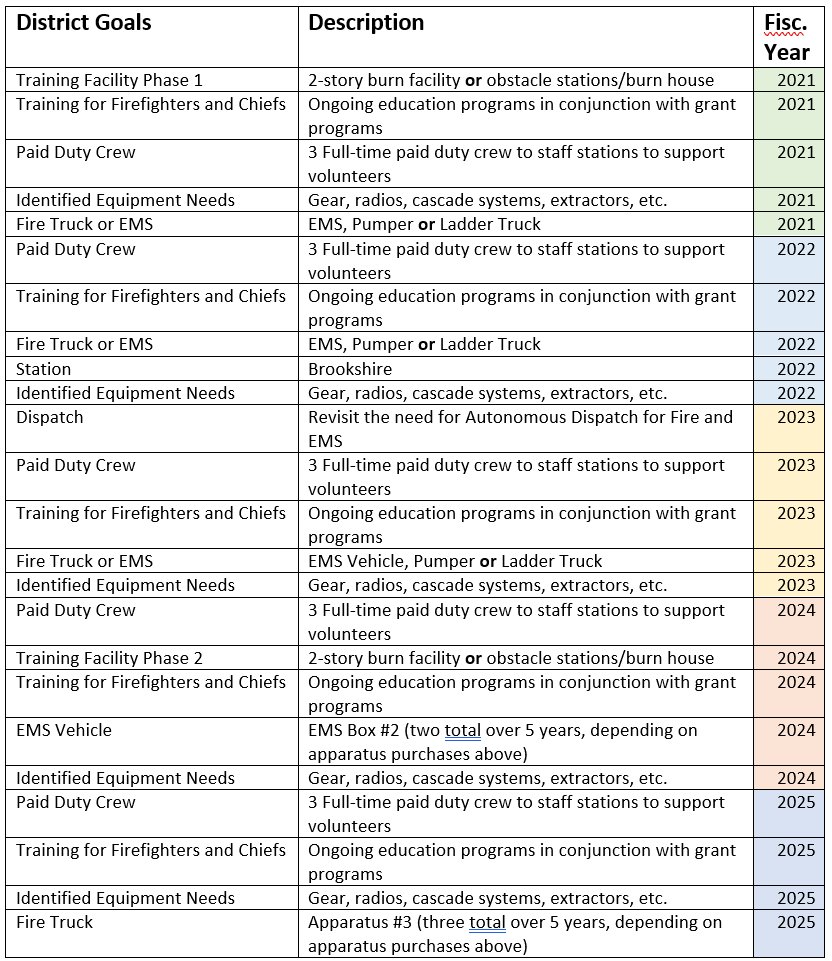Waller Harris ESD 200 asks for voter approval of 1% sales tax to fund emergency services
Waller Harris Emergency Services District 200 is asking voters to approve a 1% sales tax increase in unincorporated portions of the district which spans all of Waller County and a portion of Harris …
This item is available in full to subscribers.
Attention subscribers
To continue reading, you will need to either log in to your subscriber account, below, or purchase a new subscription.
Please log in to continue |
Waller Harris ESD 200 asks for voter approval of 1% sales tax to fund emergency services
Waller Harris Emergency Services District 200 is asking voters to approve a 1% sales tax increase in unincorporated portions of the district which spans all of Waller County and a portion of Harris County in the Katy and Cypress areas. Funds raised through the sales tax will be used to improve the ten volunteer fire departments the district oversees, WHESD 200 commissioners said.
“In most of the county (sales tax is set at) 6.25% and then what we’re asking for is one cent,” said WHESD 200 Commissioner Tommy Albert, who also serves as the district’s treasurer.
The general idea is to ensure the district has equipment and staff available to respond quickly to emergencies such as house fires or the more common accidents along I-10 and Hwy. 290, officials said. With the district’s property tax set at the state maximum, it isn’t enough to fund everything needed for the district’s current population growth over time, but with a sales tax the funding comes not only from residents but those traveling through the district, commissioners with the district said.
The additional penny in tax per dollar spent will only be collected outside of city limits within the district, said Simon VanDyk, WHESD 200 public information officer. As a result, purchases made within the city limits of Katy, Brookshire, Pattison, Hempstead and other towns would not incur the additional sales tax and the funds would come in through transactions made at retailers such as gas stations along I-10 and Highway 290 by both area residents and those traveling through the district.
VanDyk said online sales through Amazon or other online retailers will be impacted as well if the buyer’s home is within the district.
Currently, the district serves about 230 square miles through ten volunteer fire departments which is funded through a $0.1000 per $100 valuation property tax rate which raised about $6 million for the 2019 budget and $7 million for the 2020 budget. The ten-cent tax rate is the highest an ESD can assess under Texas law, VanDyk said. As the district grows, this puts a strain on the district to serve everyone.
“(Seven) million dollars only goes so far,” said Commissioner Rick Dalton.
Dalton and Albert, along with District Chief Safety Officer Jimmie Orsak said the roughly $1.5 million per year that the sales tax proceeds are expected to generate would help the district ensure timely service to all residents of the district. With the current budget coming only from ad valorem taxes, revenue is not sufficient to keep up with population growth and increased traffic on I-10 and Hwy. 290, they said. Especially with responses to accidents on those two major thoroughfares being the most common call the district responds to. Without the added funding, they said, fire and EMS crews are stretched thin.
“Well, now we’re doing right at 600 calls a month,” Orsak said. “Six hundred calls a month with five ambulances full time, 24-seven.”
Orsak said the strain on those crews forces the district to move assets around the county to back one another up and can lead to longer than desired response times for EMS calls. Currently, EMS calls can take as long as 30 minutes if the nearest ambulance crew is taken up and a backup has to come from the other end of the district, he said.
The National Fire Protection Association sets the ideal response time for an EMS call at seven minutes.
Further, part of the proceeds would go to adding additional ambulances and professional firefighters to help supplement the volunteers and ensure the volunteers have additional training opportunities and support as population growth continues, Orsak said.
Specifically, according to the ESD’s election documentation posted online, funding raised by the sales tax in 2021 would go toward setting up a two-story fire training facility, training for firefighters and fire chiefs, three full time duty crew to staff stations throughout the district, equipment and an ambulance and pumper truck or ladder truck. In 2022, three additional full timers would be added with additional training, trucks and equipment as well as a new fire station in the city of Brookshire. Dispatch improvements would be addressed in 2023 as well as more full time staff, and equipment. Both 2024 and 2025 would see similar improvements.
“Our duty crews currently are only responding to emergency calls,” Orsak said. “And with lack of bandwidth and a large coverage area, that’s critical because you get a certified firefighter with EMT basic (certification) on scene to start providing that patient care.”
However, in order to maintain that standard and improve service, the district needs the additional funding, commissioners said.
“Looking at call volumes alone, we’ve got to do something to shore up that south side (of the district) in the Brookshire area,” VanDyk said. “Right now, if there was a major incident – let’s say a Harvey was coming in – that facility down there currently won’t do it. It literally is the old youth group building (for one of the churches in Brookshire.)”
Correction: This article previously listed Jimmie Orsak's title as commissioner. He is the Chief Safety Officer for the District. His title has been corrected in the article.
Keywords
WHESD 200, Waller Harris ESD 200, Sales Tax, Simon VanDyk, Tommy Albert, Rick Dalton, Jimmie Orsak

